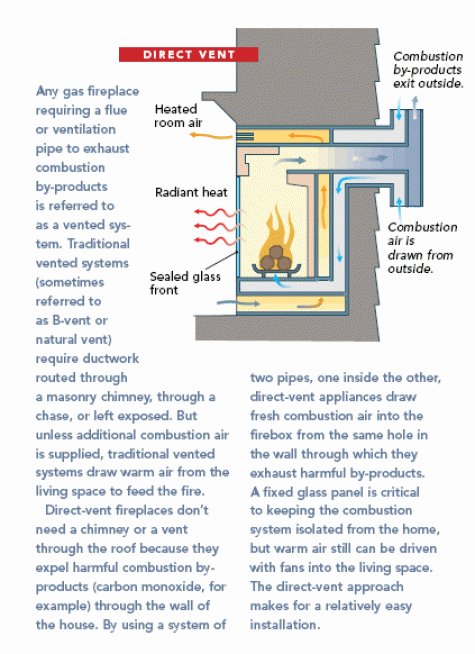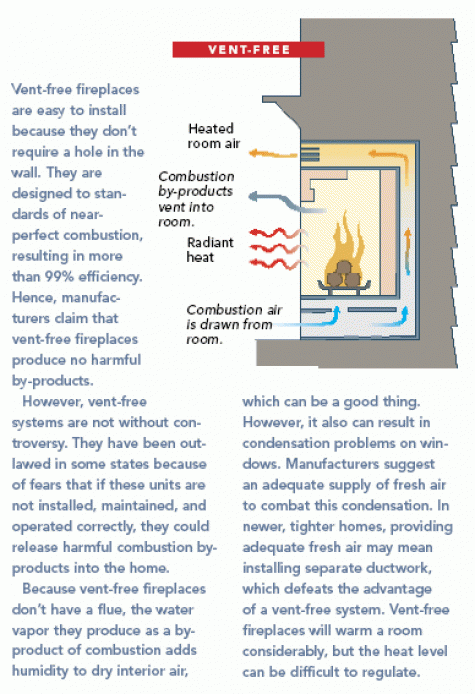
Back in issue #171, I wrote a piece for our What’s the Difference? department that briefly compared the pros and cons of direct vent vs. vent-free gas fireplaces.
The day that the issue hit newsstands, we received an angry letter:
“I’m sorry that you didn’t call the Vent-Free Gas Products Alliance to determine exactly what information was missing or miused in your discussion…why didn’t you print that your readers could request a free copy of the consumer guide…rather than try to scare them. Why would so many manufacturers produce these products if there were any problems?”
…and quite literally minutes later we received a second (also angry) letter:
“I find it unbelievable that you can uncritically compare sealed-combustion to vent-free gas appliances…any heating appliance that requires an open window to ensure safety is incomprehensible…I would never suggest to anyone that these two technologies are a matter of personal choice…you have a responsibility to your readers to discern the difference between manufacturers’ hype and real world consequences.”
My (then) editor-in-chief Kevin Ireton walked by my office and said “well, we must have done something right to fire ’em up like that”
So, I’m wondering what you think. I’ve attached the original What’s the Difference? writeups, but I think the discussion is not about what we got right and wrong in the article, it’s about whether vent-free appliances really are an acceptable (smart?) choice…


Fine Homebuilding Recommended Products
Fine Homebuilding receives a commission for items purchased through links on this site, including Amazon Associates and other affiliate advertising programs.

8067 All-Weather Flashing Tape

Affordable IR Camera

Reliable Crimp Connectors





























View Comments
This issue is one that I have struggled with for years since I'm a code official (mechanical and plumbing.)
The International Fuel Gas Code, the Uniform Mechanical Code, as well as NFPA 54 all allow ventless heaters with certain restrictions and requirements. Some jurisdictions have amended these codes so as to prohibit ventless room heaters in residences. In the process that led to their approval,the code-writing bodies reviewed the claims of the makers of ventless appliance room heaters and fireplaces and came to the conclusion that they were safe if installed as directed by the manufacturer.
However, I have to wonder if the evidence was complete since the studies in favor of the ventlsss appliances were all paid for by the manufacturers, as far as I know. As I recall, the studies claimed that not a single death had been attributed to properly installed ventless heaters. That may still be the case, but even so, there may be cases not documented, or cases of illness resulting from low-level CO poisoning that have never come to light, and, in fact, may not even be suspected by the occupants using ventless heaters since CO poisoning mimics symptoms of common illnesses, or aggravates existing illnesses.
The safety feature of these heaters is what the manufacturers call an ODS (oxygen depletion sensor), which is nothing more than a tilted pilot flame, which, in the event that the normal oxygen level(21%)drops below 19 or 20 per cent, causes the tilted flame to pull away from the thermocouple, thereby shutting off the appliance's main gas valve.
BUT, if the reason that the oxygen level has dropped by 1 or 2 per cent is because it has been replaced with carbon monoxide, that would be fatal. (1% CO translates to 10,000 parts per million; 400 ppm can be fatal in a few hours' esposure.) Of course, if this were happening even rarely, there would be immediate outrage along with calls to ban ventless appliances, and manufacturers would pull out of the market due to the huge liability and the fact that none of them are in business with the intent to do harm to even one person. My point is that the ODS is incapable of detecting low-level CO, which might go undetected for months. Dirty burners can produce CO even in the presence of adequate oxygen levels.
It would be very useful if there were some way to verify, collect and publish any cases where ventless heaters were the cause of illness or other problems. Maybe no such cases exist, but I doubt that. I appreciate FHB's efforts to shed more light on this issue.
There is no such thing as a vent-free gas fireplace. 'Vent-free' is just a marketing term. All gas fired appliances have exhaust. And 'vent-free' models vent the exhaust inside the house.
Most naysayers focus on the potential CO issues and they may have a point. But what about the moisture vapor. I've been called in to look at several homes with 'moisture problems' where the culprit turned out to be gas fired appliances exhausting inside the house. The RH was topping 70% and even though these homes have mechanical ventilation systems set for normal household moisture levels (showering, respiring, pets, plants) they couldn't handle the 'vent-free' fireplace.
I'm not sure why California prohibits the sale and installation of 'vent-free' fireplaces but they may be onto something.
I've been on the fence due to the safety issue, but for wood burners this is ideal. Half my house is heated by a wood stove, and I struggle to keep my humidity level at 25%. Having a vent-free at the other end of the house and circulating the air would give me extremely efficient heat for the rest of the house, higher humidity throughout, and mitigate the air quality problems, since the percent of "bad air" would be spread throughout a larger space.
Any thoughts on this application?
First, I am critical of the assumption that the vent-free models are producing CO. Proper combustion would have them producing CO2 ... a much safer gas.
You can be sure that these products, and especially ones with a UL lable, have had the Co issue thoroughly evaluated. In the case of UL, you can be sure various tests were actually performed, simulating a variety of fault conditions. I'm not worried about their safety.
What I am worried about - what 3-1/2 years of living in a camper taught me - is another product of combustion: water. Burning gas (natural or propane) creates an enormous amount of water. That water has to go somewhere.
So, I think the idea of using 'vent free' in a tightly sealed place is a mistake. Now, if your place is like mine, where a strong wind moves the drapes even when the windows are closed, then you have enough leakage for the appliance to work. Of course, the water probably condenses inside the insulation, making the fiberglass nice and soggy- but that's another topic.
For occasional heat, or even decorative use as a fireplace, I believe there is a role for ventless appliances. I thing they are great for cabins, workshops, and storage lockers. For permanant heating of continuously occupied places, I'd use something else.
Excellant article!
I have always thought supplying outside air directly into the firebox is a huge energy saver for any kind of fireplace, gas logs or wood burning. You can get the benefit of the radiant heat without pulling in cold air through the rest of the house.
I would like to install a direct vent unit like the one you show in your diagram. Is the direct vent design for gas logs being manufactured and available on the market now ?
Excellant article!
I have always thought supplying outside air directly into the firebox is a huge energy saver for any kind of fireplace, gas logs or wood burning. You can get the benefit of the radiant heat without pulling in cold air through the rest of the house.
I would like to install a direct vent unit like the one you show in your diagram. Is the direct vent design for gas logs being manufactured and available on the market now ?
Question: Could I not install a "direct vent" firebox in my existing masonry chimney which was previously used for wood fires? Would I need new ductwork up the chimney? How about the fresh air supply? The house is 40 years old.
Vent free or ventless fireplaces have been in use for over 20 years. There are NO hard facts to back up these claims.
Ventless fireplaces are 99% efficient safe and UL tested.
Vent free fireplaces are safer than gas cooking range.
Be careful of “self-proclaimed” experts who really don’t know what they are talking about.
I've been researching this issue because I have to put a heater in my 50'x50'x24' garage. It is very well insulated (foam), and being in Texas, will be used used only during the Nov-Feb months. From what I've found, and what I am most concerned about, is the moisture a vent-free system puts into the air. It seems the moisture can wreak havoc on tools that will collect condensation and result in accelerated rusting of tools and equipment. So I am leaning toward a vented system. Anyone have this experience with rusting tools?